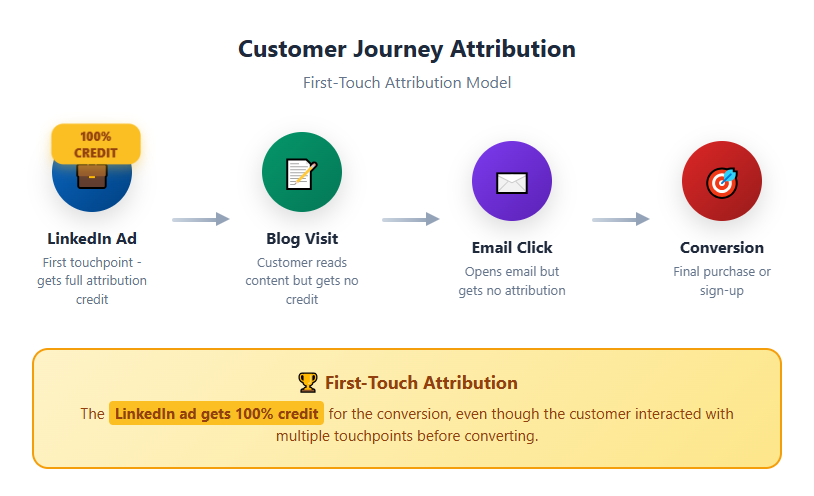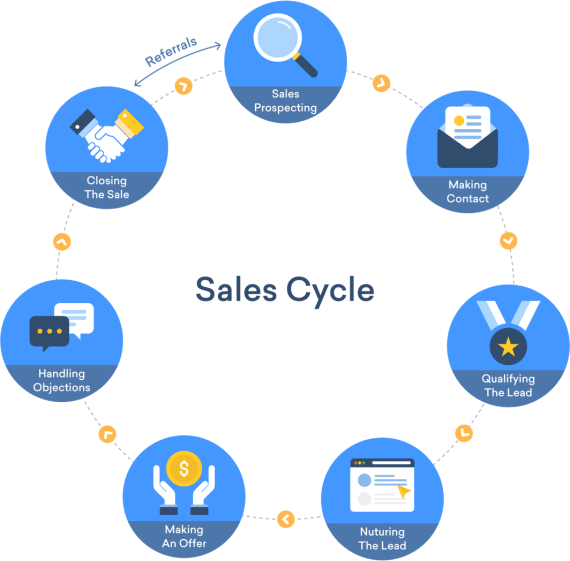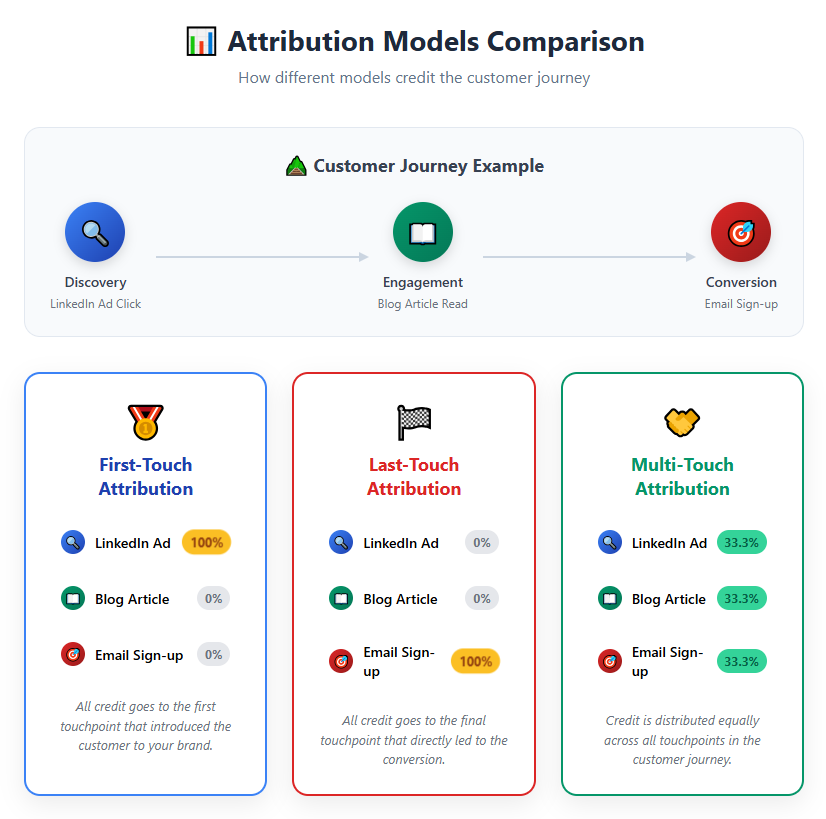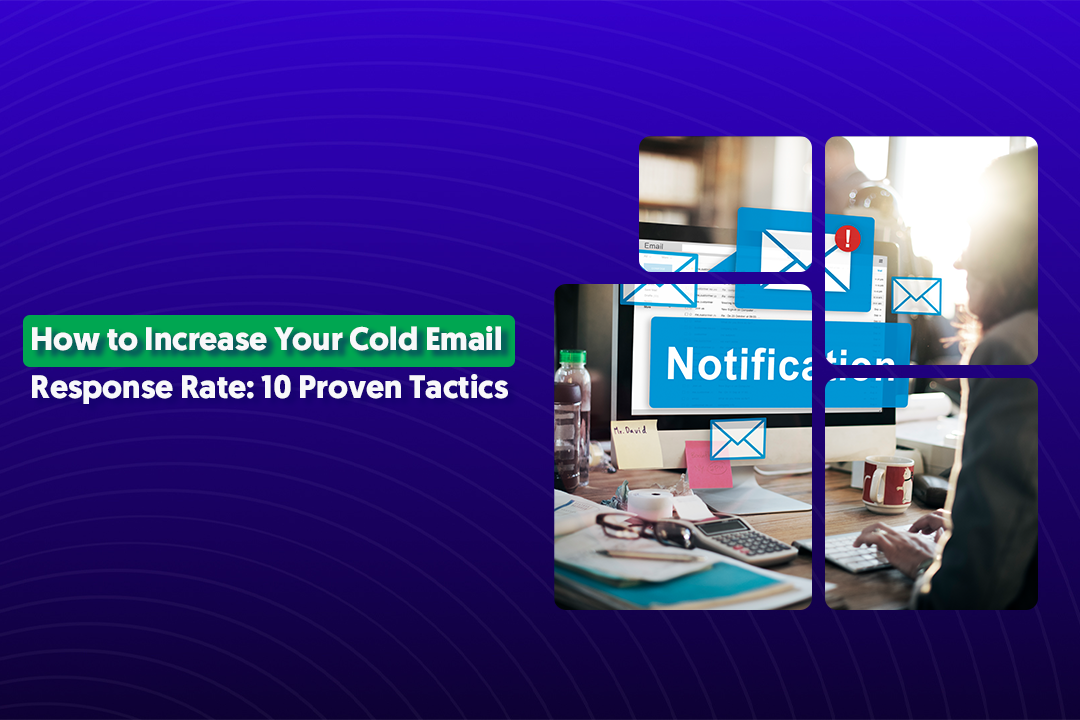Table of Content
Key Takeaways
- First touch attribution gives full credit to the very first interaction a prospect has with your brand.
- It helps identify which channels are most effective at driving top-of-funnel awareness.
- The model is simple, making it ideal for early-stage companies or straightforward campaigns.
- Budget allocation becomes easier when you know which campaigns generate initial engagement.
- It works well for tracking content marketing, PPC campaigns, webinars, and events.
- Limitations include ignoring mid-funnel and closing interactions in long sales cycles.
- Combining first touch attribution with multi-touch or last-touch models provides a more complete view of the customer journey.
- For lead generation agencies, understanding first-touch attribution is crucial to optimizing outreach and campaign strategies.
In B2B lead generation, if you’ve ever tried to figure out which of your marketing efforts actually bring in new leads, you already know how tricky it can be. That’s where attribution models come in.
Marketers use these models to connect the dots between campaigns and revenue, making it easier to measure ROI and decide where to put more time and budget.
So, what is first touch attribution? In simple words, it’s a way to give credit to the very first interaction a prospect has with your business, whether that’s a blog post, a paid ad, or a LinkedIn campaign.
It helps you see which channels are most effective at creating awareness and starting the customer journey.
In this blog, we’ll break down:
- The definition of first touch attribution and why it matters
- How first touch attribution works in practice
- The pros and cons of using a first touch attribution model
- Examples of first touch attribution in marketing
By the end, you’ll have a clear understanding of whether this model is right for your business and how you can use it to optimize your lead generation strategy.
What Is First-Touch Attribution?
At its core, first touch attribution is a model that gives full credit to the very first interaction a prospect has with your brand.
In other words, it answers the question: “what is first touch attribution?” by showing which channel or campaign first introduced a potential customer to your business.
Think of it like this: If someone discovers your blog post through a LinkedIn ad, reads it, and later converts into a lead via an email campaign, the first touch attribution model credits that initial LinkedIn interaction for starting the relationship.
Here’s why it matters:
- Top-of-funnel insight: It helps you understand which channels are most effective at generating awareness.
- Better budget allocation: You can invest more in campaigns that are proven to bring in first-time visitors.
- Lead generation focus: For a lead generation agency like us, it’s crucial to track how prospects enter the B2B funnel so we can optimize outreach and engagement strategies.
Identifying the first point of contact, first touch attribution provides a clear picture of how your marketing efforts contribute to attracting new leads, making it a vital tool for any data-driven marketing strategy.
How Does First-Touch Attribution Work?
Understanding how first touch attribution works is key if you want to see which marketing efforts are actually introducing new prospects to your business.
Let’s break it down step by step.
Identifying the First Touchpoint
The first step is figuring out where the journey begins. A touchpoint is any interaction a prospect has with your brand. Common examples include:
- Organic search: Someone finds your blog post or website via Google.
- Ad click: A prospect clicks on a paid ad, such as LinkedIn or Google Ads.
- Email campaign: The first time a lead opens or clicks a marketing email.
- Event or webinar: Attending an offline or virtual event that introduces them to your business.
By identifying the first touchpoint, you can see which channels are most effective at creating awareness and starting the lead generation process.
Tracking & Analytics Tools
Next, you need the right tools to capture these interactions. Some of the most commonly used tools include:
- Google Analytics: Tracks website visits, referral sources, and UTM parameters.
- HubSpot or Salesforce CRM: Monitors how leads engage across multiple channels.
- Marketing attribution software: Specialized platforms that map the entire customer journey and assign credit to different touchpoints.
With these tools, you can clearly see the first interaction that eventually leads to a conversion.
Data Collection Process
Collecting accurate data is essential. Here’s how how first touch attribution works behind the scenes:
- Cookies: Track users’ first visit to your website.
- CRM integration: Sync lead data from your marketing and sales tools to capture the first interaction.
- UTM parameters: Add tags to URLs in campaigns (email, ads, social) so you know which campaign generated the first click.
This ensures that every first interaction is recorded properly and linked to future conversions.
Reporting the Conversion Path
Finally, the data is compiled into a conversion path report, which focuses solely on the first touch. This means:
- Only the initial interaction gets credit for the conversion, even if the lead interacts with multiple campaigns afterward.
- It allows you to measure which channels are most effective at bringing new leads into your funnel.
- For example, if a prospect first clicks a LinkedIn ad, later reads a blog post, and finally fills out a contact form, the LinkedIn ad gets 100% credit in a first touch attribution model.
By clearly reporting the first touch, you can make informed decisions about where to focus your marketing budget and strategy to maximize lead generation.

The First-Touch Attribution Model Explained
The first touch attribution model is one of the simplest yet most insightful ways to understand how your marketing channels contribute to new lead generation.
Let’s break down exactly what this model looks like and how it works in practice.
Breakdown of the Model’s Structure
In the first touch attribution model, 100% of the credit for a conversion goes to the very first interaction a prospect has with your brand.
Unlike other attribution models that divide credit across multiple touchpoints, this model focuses solely on the origin point of the lead journey.
Here’s a simple structure:
- Prospect discovers your brand (first touch) → full credit goes here
- Prospect engages with other channels (blog posts, emails, ads) → no credit assigned
- Prospect converts (fills out a form, subscribes, makes a purchase) → all credit remains with the first touch
This makes it easy to see which channels are most effective at attracting new leads, especially in the top-of-funnel stage.
Example
Imagine a prospect’s journey like this:
- Step 1: Clicks a LinkedIn ad → first touch (100% credit)
- Step 2: Reads a blog post
- Step 3: Opens a marketing email
- Step 4: Fills out a contact form
In the first touch attribution model, only the LinkedIn ad gets credit for the conversion.

Common Scenarios Where It’s Applied
The first touch attribution model works best in situations where understanding initial engagement is critical. Some common applications include:
- Content marketing: Identifying which blog posts or guides first attract potential leads.
- PPC campaigns: Understanding which paid ads generate first-time visits to your website.
- Webinars & events: Tracking attendees who are introduced to your brand for the first time.
- Social media campaigns: Seeing which social channels are most effective at building awareness.
Benefits of First-Touch Attribution in Marketing
Using first touch attribution in marketing can give you clear insights into which channels are truly bringing new leads into your funnel.
While no model is perfect, the simplicity and focus on the first interaction make it extremely useful, especially for companies looking to optimize their top-of-funnel efforts.
Helps Identify Top-of-Funnel Drivers
One of the biggest advantages of first touch attribution in marketing is that it shows you exactly which channels are driving awareness.
For example:
- SEO: Discover which blog posts or organic search queries attract your first-time visitors.
- Paid ads: Identify which LinkedIn or Google Ads campaigns are most effective at getting prospects to notice your brand.
- Events & webinars: Track which offline or online events are introducing new leads to your business.
By knowing your top-of-funnel drivers, you can double down on the channels that kickstart the customer journey.

Budget Allocation for Awareness Campaigns
Because the model gives full credit to the first touch, it makes budget decisions for awareness campaigns much easier.
If you see that certain campaigns consistently generate the first interaction for leads, you can confidently allocate more budget toward those channels rather than spreading resources thin across multiple initiatives.
Simplicity of the Model for Early-Stage Companies
For smaller or early-stage companies, complex attribution models can feel overwhelming. The first touch attribution model is simple and straightforward:
- Track the first interaction
- Assign 100% credit
- Make data-driven decisions
This simplicity allows early-stage companies to quickly understand what works without needing advanced analytics or multiple tools.
Clear Insights for Lead Acquisition Sources
Finally, first touch attribution in marketing provides clarity on where your leads are coming from.
By seeing which campaigns or channels introduce prospects first, you can optimize content, ads, and outreach strategies to generate more qualified leads.
Limitations of First-Touch Attribution
While first touch attribution provides valuable insights into the first interaction that drives a lead, it’s important to understand its limitations.
Like any single attribution model, it doesn’t give the full picture of a prospect’s journey.
Doesn’t Consider Mid-Funnel & Closing Touchpoints
One of the main first touch attribution limitations is that it ignores all interactions after the first touch.
For example, if a lead first finds your brand via a blog post but later engages with multiple emails, webinars, or sales calls before converting, those middle and closing interactions receive no credit. This can make it harder to understand which campaigns actually nurture leads toward conversion.
Risk of Overvaluing Early Interactions
Because this model assigns 100% of credit to the first touch, there’s a risk of overvaluing early interactions. A channel that introduces the lead but has minimal influence on the final decision may appear more effective than it truly is.
For instance, a social media post might get the first click, but a targeted demo email may actually convince the lead to convert—yet it won’t get any credit under this model.
Not Ideal for Long & Complex B2B Sales Cycles
For businesses with long or complex B2B sales cycles, the first touch attribution limitations become more apparent. Leads often interact with multiple touchpoints over weeks or months, making it difficult to rely solely on the first interaction for strategic decisions.
Without considering mid-funnel and closing touchpoints, marketers may misallocate budgets or undervalue nurturing campaigns.

Why Marketers Often Combine It With Other Models
To address these limitations, many marketers combine first touch attribution with multi-touch models. By doing so, you can:
- Understand the full customer journey from first interaction to conversion
- Balance credit between top-of-funnel awareness and mid- to bottom-funnel engagement
- Make more informed decisions for budget allocation and campaign optimization
First-Touch Attribution vs. Other Attribution Models
Understanding first touch attribution vs other attribution models is essential if you want to make informed decisions about your marketing strategy.
Each model has its strengths and weaknesses, and knowing the differences helps you choose the right one for your business.
First-Touch vs. Last-Touch Attribution
The key difference between first-touch and last-touch attribution lies in which interaction receives credit:
- First-touch attribution: Gives 100% of the credit to the initial interaction a prospect has with your brand. Great for identifying top-of-funnel drivers.
- Last-touch attribution: Gives full credit to the final interaction before conversion. This is useful for understanding which touchpoints actually close leads.
For example, if a lead first clicks a LinkedIn ad and later converts via a demo email, first-touch attribution credits the LinkedIn ad, while last-touch attribution credits the demo email.
First-Touch vs. Multi-Touch Attribution
Multi-touch attribution splits credit across multiple interactions along the customer journey, such as:
- 40% to the first touch
- 40% to the last touch
- 20% to key mid-funnel engagements
Compared to first-touch attribution, multi-touch gives a more complete picture of which channels contribute to lead nurturing and conversions.
However, it’s more complex to implement and requires robust tracking tools.
Which One Should B2B Marketers Choose?
For B2B marketers and lead generation agencies, the choice depends on your goals:
- Use first-touch attribution if your goal is to identify top-of-funnel channels and understand which campaigns are best at generating new leads.
- Use last-touch attribution if you want to optimize conversion-focused campaigns.
- Use multi-touch attribution if you want a comprehensive view of the entire customer journey, especially for long sales cycles.
At Cleverly, we often combine insights from multiple models, giving our clients the ability to track, optimize, and allocate resources effectively across the funnel.

Cleverly’s Lead Generation Services: Drive First Touches That Convert
At Cleverly, we’re more than just a lead generation agency, we’re your partner in creating first touchpoints that actually convert.
With a done-for-you lead gen approach, we help businesses like yours connect with the right prospects at the very start of their journey.
We specialize in generating B2B leads through:
- LinkedIn lead generation: Strategic outreach to your ideal decision-makers.
- Cold email campaigns: Personalized messages that spark interest and engagement.
- Cold calling: High-converting calls that turn prospects into leads.

Over the years, we’ve helped over 10,000 clients generate leads for companies like Amazon, Google, Uber, PayPal, Slack, Spotify, and many more.
The results speak for themselves:
- 224.7K client leads generated
- $312M in pipeline revenue
- $51.2M in closed revenue
By focusing on creating impactful first touchpoints, we ensure your prospects are not just aware of your brand, but are primed to engage and convert. That’s the power of combining top-of-funnel strategy with expert execution!
So, ready to get started and fill your lead pipeline? Book a 15-min call to discuss!

Conclusion
First touch attribution is a simple yet powerful way to understand which marketing channels are introducing new leads to your business.
By giving full credit to the initial interaction, it helps you identify top-of-funnel drivers, allocate budgets more effectively, and measure the impact of awareness campaigns.
The benefits are clear:
- Pinpoint which channels bring in the first-time visitors and potential leads.
- Make smarter decisions on budget allocation for awareness campaigns.
- Gain actionable insights into how prospects enter your funnel.
At the same time, it’s important to maintain a balanced perspective. While first touch attribution shows the origin of leads, it doesn’t account for mid-funnel or closing interactions.
Combining it with other attribution models, such as multi-touch or last-touch, provides a complete picture of the customer journey and ensures that every interaction is properly valued.
By understanding and leveraging first touch attribution, you can optimize your marketing strategy, drive more meaningful first interactions, and ultimately generate higher-quality leads for your business.
Frequently Asked Questions





